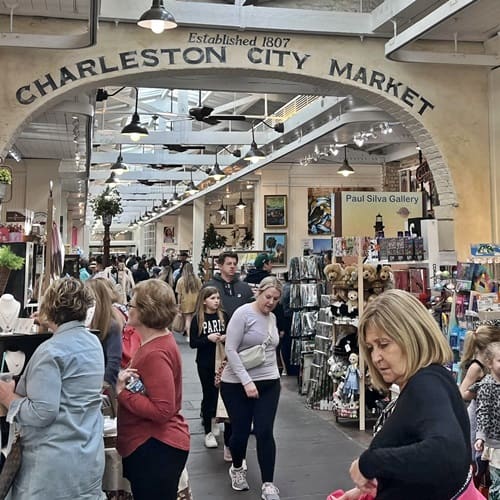
Charleston TourPass
You can view Featured Tour availability prior to purchasing a pass
(Does not show times for Standard Attractions that you can visit anytime during their operating hours)
The City Market is a famous Charleston landmark and a favorite of visitors. Encompassing four city blocks from Meeting to East Bay Streets, the City Market houses is known for Sweetgrass baskets, tremendous restaurants, bars, local vendors selling everything from jewelery to novelty items and is where the immensely popular carriage tours depart from.
Market Hall Painstakingly restored, this Roman Revival building soars as majestically above Charleston’s tourism trade as it once did over the beef market that occupied the block behind it. While most of the building is brick covered with rouge-tinted stucco (colored in some areas with pigmented lime wash), it also has brownstone details and bronze ornaments in the frieze depicting the skulls of rams and oxen, the use of which to indicate proximity to a meat market has precedence in Roman architecture.
During the Civil War, the upper floor was used as a venue for balls to support the Confederate cause and is today leased by the Daughters of the Confederacy where a museum is housed. The legendary Palmetto Guard was honored here before going to war, and the veterans gathered here annually to remember their fallen comrades through 1917, when the last two survivors met.
City Market Where the City Market now stands was originally a tidal creek that ran just north of the walled Colonial city of Charles Towne. The creek was filled in and the land donated to the city for the placement of an open-air food market, a purpose the present buildings served from 1804 until the early 20th century. Victorian era photographs show basket-toting women in the streets at the Beef Market, dodging turkey buzzards (euphemistically referred to in contemporary accounts as “Charleston eagles”), which kept the area clean.
Among the vendors who now occupy the Market are ladies demonstrating the originally African craft of sweetgrass basketry, the most visible vestige of Gullah culture. The word “Gullah” likely originated from the word “Angola”, which in the early 18th-century referred to the region generally south of the Congo River from which most slaves were brought. By mid-century, Planters were showing a distinct preference for Slaves from the coastal areas above the Congo, where rice was a major crop and methods from those areas were being employed in the Lowcountry rice industry. Baskets like these were used for winnowing – tossing the pounded grains through the air to let the breeze carry away the chaff – and virtually identical baskets found in Senegal Africa were used there for the same purpose.
See map below for address
The Tour Pass for Charleston was so easy to use to get into all the attractions on the list and customer service was quick to respond and very kind. I would definitely purchase again!
Bought the Tour Pass for Charlestown, SC. Besides food I didn’t spend money on anything else— I was able to take Horse-drawn tours- Boat tours and countless free entries to museums, Aquarium etc. I was even telling the Uber Drivers about it so they could pass the info to other tourists!
We purchased the 2 day tour for Charleston and were so glad we did! The 3 premium tours we picked were excellent and we had fun adding the standard tours where we could fit them in. An excellent value. I would highly recommend it.
I was just scrolling on facebook when an add jumped out at me. I was planning a trip to Savannah and trying to figure out what all to do while my family was there. TourPass was a great find because you pay one time and can do multiple things in a day. They have so many options and many of them are must see/do tours so it worked out great. We really enjoyed all the tours we booked through TourPass and the app was very easy to use. I would definitely recommend using it if you’re traveling to any of the cities there are in.
We did three tours, the hop on hop off trolley tour, the guided riverboat ride and the haunted pub crawl. All were easy to find, had great narrators/tour guides and were just a lot of fun. We will definitely return soon!
The horse drawn carriage tour of Charleston was a fantastic experience, our guide Ian along with his sidekick Chester did a wonderful job! We would highly suggest this tour!!
The kayaking experience was a different in that there was not a calming experience through the Marina, you had to jockey around boats and fisherman lines heading out into open water, it was quite busy with both of those issues. This tour was okay.
Great way to see the town! One pass with sooo many options. We went on our favorite tour with this pass. Savannah Port Tour! We got to see so much in a day. Easy to use as well. We had no problems checking into any tour or house. Another good thing about the pass…. Not sure we would have known about all these options without the pass! Many thanks!
I purchased the Tour Pass for two people for 2 days. We started early each day and tried to experience as many opportunities as we could. Using it was super easy and we saved money over the individual admission prices. I highly recommend!
This pass was great. I was able to take multiple tours and they were all included in the price. I will defiantly use this option again when traveling.
We got the 4 day pass and spent 1 full week in Charelston. We scheduled 4 featured tours for each night/day and filled in the rest of the time with the amazing standard tours. It made our stay a great time. I recommend this pass.
We live in Jacksonville and regularly in St. Augustine for day trips or long weekends. Tour Pass was fantastic to use during a recent long weekend visit. We booked the two-day pass to take advantage of our favorite attractions with the added benefit of trying some new things we had not visited in the MANY trips to the Old City. Unfortunately, a hurricane forced the closure of many attractions in the middle of the day on Day 2 but an email to Tour Pass was quickly responded to and offered a great solution. We loved the opportunity to revisit some attractions we had seen before and were excited to experience some for the first time. We could squeeze in quite a few in the one and a half days . We were looking forward to using Tour Pass on our next visit to Savannah!
The tour pass was awesome! We had so much to do and it was very easy and convenient to use. Definitely worth purchasing. You really end up saving money. I wish they would have more than three days max. I would definitely purchase more days. It was a wonderful trip!
Tour guide was very knowledgeable! Pass was a great savings and allowed us to do a lot more things.
Tour Pass was very convenient. Places had my name when I arrived. Didn't have to buy tickets
Just showed my passed and I was in. Got alot for the money. I bought 3 day pass. Used it those 3 days in Charleston.
Me and my besties took advantage of the one day pass! Wow did we get our money’s worth! We didn’t get to do everything, but out of the stops we did visit, really worth the price!! I def recommend! Probs would do it again too!! Ha! Loved it, and such a great time visiting St. Auggie! ;)

Pass purchases can be refunded (minus 3% credit card processing fees) if requested within thirty-days of purchase date (for unused passes). Optional Trip Insurance can be purchased for a nominal fee at checkout which extends the refund period up to one-year from purchase date. Conditions apply. View full refund policy by clicking button below.